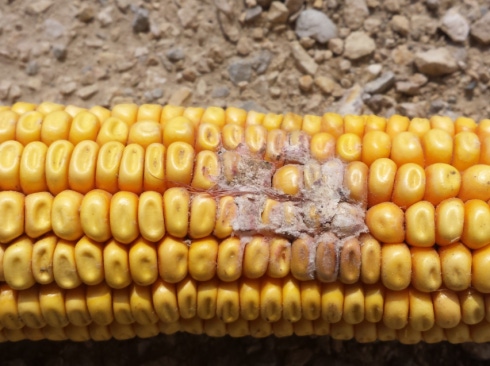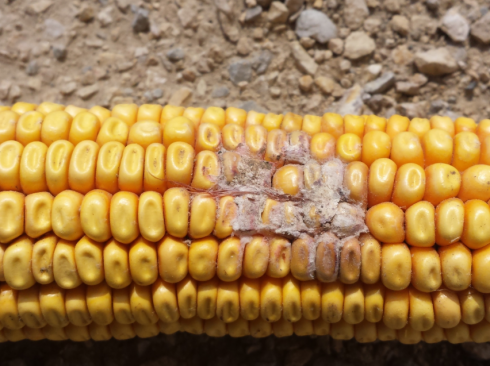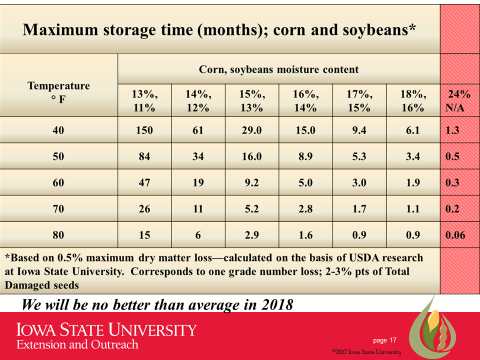October 17, 2018

Above normal rains in September have slowed field crop dry-down. Coupled with early season drought in South Central and Southeast Iowa and above-average rainfall in the Northwest, there is high risk of reduced grain quality. Corn and soybeans remaining in the field are currently exposed to excessive moisture that encourages the growth of ear molds. Moldy kernels are counted in total damage, thereby affecting the overall grade of the corn. Additionally, if the fungus is capable of producing mycotoxins, affected grain may be subject to marketing restrictions.
Not all fungi produce mycotoxins. Ear rot identification is key to assessing if and for which mycotoxins you are at risk. Check out Crop Protection Network’s document CPN-2001 Corn-Ear Rots found in their online library. Generally, be watchful for vomitoxin (also known as deoxynivalenol or DON) and zearalenone in the northern half of the state—these two mycotoxins are produced by the same fungus. Aflatoxin and fumonisin are the predominant risk in the southern portions of the state. Sporadic risk exists in between with cool, wet growing conditions favoring vomitoxin and zearalenone and hot and dry conditions favoring aflatoxins or fumonisins. If weather hinders harvest, consider scouting fields to assess the presence, extent and severity of fungal-infected ears. Suggested scouting methods can be found in Section 6 of the document CPN-2002 Mycotoxin FAQs Crop Protection Network document and in the section “How to prevent aflatoxin in corn” found in the Aflatoxins in Corn document.

Harvest and post-harvest management
Adjust combine settings to minimize damage to grain. High dewpoints are limiting storage aeration and mycotoxin levels can increase rapidly in high moisture corn. One research study reported a 77% increase in fumonisin levels in 25% moisture corn over seven days [1]. When possible, utilize a dryer that will reduce moisture content rapidly prior to grain storage. Avoid overheating to the point that stress cracks develop in the kernels, as these are entry points for fungus through the seed coat and into the interior of the kernel. Recommended maximum limit for kernel temperature is 180°F. Mycotoxins will not decrease in the field or in storage, but they will get worse if grain is not maintained properly.
The maximum storage time table below provides estimates for grain storability at various moisture and temperature combinations. These recommendations are for sound, good quality grain; storage times for poor quality or damaged grain should be reduced by about half. Example, 18% moisture corn which has a high incidence of field mold would have a storage life of only 1.7 months at 50°F compared to sound, high quality 18% moisture corn which could be stored at the same temperature for about 3.4 months. Mold and mycotoxin issues tend to be worse on broken and damaged kernels and fines relative to sound, whole kernels. Core bins (without a spreader) to remove the majority of broken kernels and fines (the highest-risk portion) and to improve bin airflow. Document CPN-2004 produced by the Crop Protection Network is an excellent resource on best management practices from harvest to storage for at-risk grain. If aflatoxins are a significant issue in your fields, crop insurance adjusters will want to see the affected corn still in the field.

Sampling and testing
Mycotoxins tend to occur sporadically throughout a field and among kernels on an ear. The level of mycotoxin contamination also varies greatly among the individual kernels on an ear. Representative sampling is crucial to achieving an accurate mycotoxin test result. Ideally samples are comprised of kernels obtained from throughout the lot (e.g., from multiple locations/units, representing many ears) be it a field, a bin, or from a composite of multiple grain deliveries at an elevator. It takes relatively few kernels to contaminate a load at a level that would incite marketing restrictions, so enough grain must be collected to ensure you have a chance of sampling those affected kernels. Obtain at least two pounds of material and, ideally, 5-10 pounds if feasible. Larger samples of whole kernel material provide greater lot representation. A scoop of corn off the top of a truck will not accurately depict the whole load. Data from individual loads is notoriously more variable than a composite of multiple loads in a time period. Likewise, for bins, a composite acquired from throughout the bin will yield a more true result than a single probe taken from one location.
After a representative sample is collected, it can be prepared and analyzed in-house or sent to an external testing lab for analysis. Whole kernel samples can be submitted for analysis to a regional FGIS location or to a state-affiliated or private laboratory near you for analysis. The Iowa State University Veterinary Diagnostic Laboratory typically accepts submissions through veterinarians, but will run fee-for-service mycotoxin analysis samples for others after setting up a billing account. Mold growth and mycotoxin content may continue to increase in high-moisture grain samples between the time of collection and analysis. Ideally, take subsamples of grain from out of the dryer until a representative sample of sufficient size has accumulated. A variety of rapid test kits are available on the market for in-house analysis (some of which have gone through a FGIS rapid test kit evaluation program). One key step often misinterpreted is the sample size used for analysis—this is not the amount that is ground. After the two to ten pound sample is collected or received, that entire sample should be ground followed by subdivision using a divider to obtain the amount of ground sample needed to run the analysis. Remember that a test result is only as good as the sample from which it came. It does not matter if your sample is analyzed by the simplest or most complex analysis method—if the whole corn and ground analysis sample is not representative of the entire lot, your test result will be uninformative and useless.
Summary
Wet conditions and lodged corn have created mold and sprouting issues in the 2018 corn crop still in the field. This may create mycotoxin issues in addition to moldy corn. It will be important to dry and cool corn as rapidly as possible. If mycotoxins are suspected, a well-planned representative sampling process will be needed to give useful information for processing and feeding.
You May Also Like




